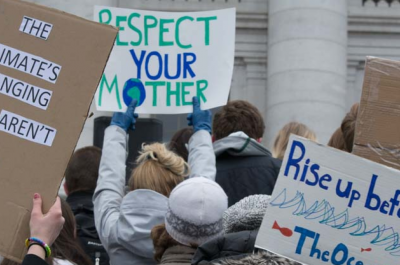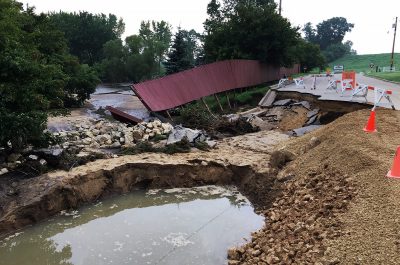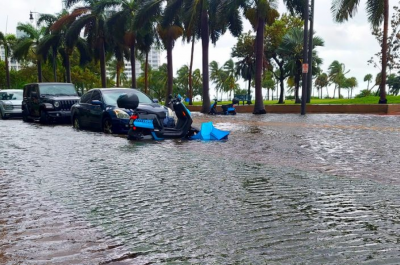We are well into the throes of 2018 and already it is proving to be a whirlwind for people and the planet. But every year, we take a moment to look back on what our community saw and compare to the bigger picture trends:
We watched as the ISeeChange community veered from one record breaking extreme to the next, and all this proved to be extra expensive. According to NOAA’s National Center for Environmental Information, 2017 was the third warmest year on record – EVER – next to 2016 and 2012. But 2017 distinguished itself as the costliest year on record too with 16 disaster events that racked up costs of over a billion dollars each. From crop losses, to virulent fire seasons, to floods and hurricanes, these extreme events all together cost the country $306 billion.
Here’s a quick recap of all 2017’s weird weather from your front steps. Your posts became the stories that are helping us better understand how climate change impacts real people, every day, all over the world.
Take a minute to reflect – how does your today compare to last year? Have you been reporting the same phenomena and seeing patterns? Did we miss anything? You can post anything on ISeeChange.org from anytime, just change the date. Every post counts to tell the bigger picture stories from your back yard- season to season, year to year.
2017’s Winter weirdness – did it even come at all?
Last year’s no-show winter may seem like a distant memory compared to this year’s holiday Arctic blasts and blizzards, but that wasn’t at all the case last winter. (Note: in some areas of the West, we’re still watching for snow to show up in 2018–so stay tuned for more on that soon).
On March 6, 2017, ISeeChanger Matt Faulkner from Rochester Hills, Michigan wrote, “This has been the year without a winter in southeast Michigan.”
In Aspen, Colorado IseeChanger Amber Kleinaman noticed the warmer weather made for lousy snow conditions for champion skiiers at the World Cup Finals.
In Wichita, Kansas, Jessica Maldonado wondered if she’d ever get to share a snowy winter with her son.
In Hebron, Connecticut, students at Rham Middle School noticed that their winter temperatures came in swings between snow and rain. They also noticed they were getting sick more than usual, so the ISeeChange team checked it out.
In Philadelphia, Kyle Johnson’s neighbors enjoyed ice cream on a warm February day.
Record high February temperatures made it hot enough for volleyball in New England.
I went to the beach and it was so warm and I took pictures and played volleyball
While record warm sea surface temperatures made it warm enough for swimming in New Jersey.
While winter in many parts of the country was mild and even snow-less. California finally got the kind of winter they’d been missing through the six year drought that began in 2011, as noted by ISeeChanger Paul Senyszyn.
Spring showed up early
With that frost-free season lengthening it comes as no surprise that spring this year arrived earlier than what was historically normal nationwide in 2017.
In late January, William Lorch found his garlic plants sending up shoots at his Joliet, Illinois home. “This usually happens mid to late April in this region,” he wrote.
Both the Southeast and the Southwest were weirdly warm and dry last January, throwing their respective agricultural seasons into turmoil as crops bloomed and developed too early.
You may not remember with the lettuce crisis of 2017 thanks to Arizona’s runaway season, but restaurant staff across the country certainly do. An early spring brought problems for Kevin Siddons in Pennsylvania and caught the eyes of Adam Mackinnon in Georgia:
My fruiting bushes started growing leaves in February. They died off in a three day cold snap.
All that warmth and early blooming in Georgia destroyed a whopping 85% of the peach crop and walloped blueberries too. These agricultural losses became among the first of the 16 billion-plus-dollar disasters in 2017.
Streets flooded across the country
Adding to the billion-dollar disaster tab came an extremely wet spring and summer across most of the United States, like in Brooklyn, Ohio and Atlanta, Georgia:
In May, New Orleanian Destiney Bell posted that the intersection outside her house turned into a lake after just a little rain.
New Orleans continued to flood all summer breaking records. ISeeChange set up an investigation in the Gentilly neighborhood to better understand the areas that flood the most and cause the most issues. Working with community-sourced stories and data, we successfully modeled the city’s flash flood events. Stay tuned for our flooding investigation results coming soon!
Wildfires blazed
With landscapes refreshed after year-long droughts, spring greenery in California and the Pacific Northwest created dangerous fire conditions.
Smoke in the bay area from the Napa fires around October 11-October 15
ISeeChange posts from the Northwest were dominated by wildfires in early fall. Schools in Portland, Oregon shut down due to smokey air and skies were hazy.
Great Northern Railway Bridge on the Similkameen River. Looking SE with smoky skies.
We looked into the impact that wildfires have on public health and learned the consequences of breathing in wildfire particles. A few months later, Southern California faced devastating wildfires which ISeeChanger Marc Federman recorded fires ablaze in Los Angeles.
Hurricane season came with a vengeance
August and September brought a constant barrage of hurricanes: Harvey, Irma, and Maria. There were devastating floods on Houston and other parts of coastal Texas.
Adam MacKinnon, posting from Sapelo Island, Georgia, witnessed beach erosion in his area.
A warm and colorless fall
For our contingent of New England ISeeChangers, fall temperatures were mild and tree leaves didn’t change with the same vibrancy as usual.
At Judy Donnelly’s home in Connecticut, the first frost of the fall didn’t come until November 9.
In Ontario, Canada, Brenda Whittaker reported that, “The colours of our leaves this fall were not as vibrant in this area. Warmer than usual temperatures. Lots of leaves still on the trees.”
An ISeeChanger from Massachusetts saw snakes sunning themselves on an warm mid-October day.
With 70+ F weather, many creatures were out sunning themselves in the Ipswich River.
Weird bugs and sea critters on the move
A tally of more than 4,000 species reveals that land species are moving an average of more than 10 miles per decade due to climate change, while marine species are moving four times faster. ISeeChangers have definitely been noticing:
Caiti Weiser in New Jersey saw ticks on her dogs, earlier than ever — months before experts began warning 2017 would be a top year for Lyme disease:
— Caiti Weiser
Meanwhile Gypsy moths continued to torment the Northeast and we took a closer look into it.
Entirely new species, like Tiger Mosquitoes, also showed up in neighborhoods.
— Mike R
In other areas, bugs that were usually present, were no-shows:
With ocean surface temperatures still anomalously warm through out the year — particularly on the East and Gulf Coast— ISeeChangers also noted strange sightings at sea. Like beached whales and octopus in North Carolina:
— Hannah Heniford
A little further South, ace observer Adam Mackinnon noted crabs on the move and sticking around.
Worldwide weirdness
Finally, the weather wasn’t just strange in the United States. The international ISeeChange community kept us posted on what climate change looks like in their countries too. We saw passion fruit growing with extra passion this winter in England:
Canadian ISeeChangers spotted mushrooms mushrooming in numbers and spotted Poison Ivy on the march:
We were alerted that Sweden— just like New England — is on high alert for deforestation thanks to moths:
Defoliation by processionary moth #ForestAlert
By the summer, Europe was in the throws of an extreme heat — dubbed “Lucifer” from the UK to Stockholm and Eastern Europe.
95 degrees F. 6/27 & 28. Unusual for summer, esp. so early. In Stockholm on 6/31 – 32 degrees F.
Lots of warmth makes for drought and we saw it in both Sri Lanka and Kenya (more on this soon!)
Finally dust storms made for uncomfortable commutes in Kuwait.
Dust storm 1/2 in Kuwait and climate is little hot ….
— Uma Dotc
Looking to 2018
In the coming year we will continue to watch your posts to identify climate issues that people around the world are facing. Often ISeeChangers are noticing important trends long before scientists, governments, and mainstream media.
As we barrel into an already eventful 2018, we want to know what’s happening in your backyard, so keep posting!
Story by Samantha Harrington for ISeeChange in Partnership with Yale Climate Connections
Cover art by “Skeeze“/Pixabay and Creative Commons




